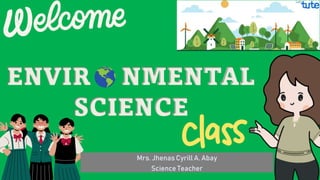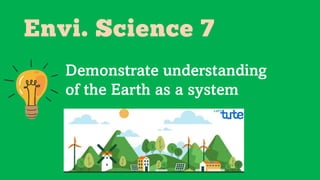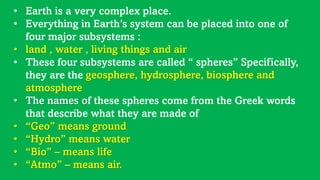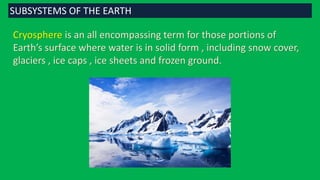Q1 M2.pptx module 2 envi science
- 1. Mrs. Jhenas Cyrill A. Abay Science Teacher ENVIR NMENTAL SCIENCE
- 2. How do you feel today?
- 3. Demonstrate understanding of the Earth as a system
- 4. 1. 1. The interior of the Earth is part of which ŌĆ£sphereŌĆØ ? a. Hydrosphere b. Geosphere c. Atmosphere d. Biosphere 2. Which is NOT one of the EarthŌĆÖs four sphere? a. Troposphere b. Geosphere c. Hydrosphere d. Biosphere
- 5. 3. Which of the following is NOT part of the hydrologic cycle? a. Evaporation b. Precipitation c. Condensation d. Accumulation
- 6. 4. Which of the statements is NOT true? a. Water can be created b. Water is cycled c. The majority of water found on Earth is freshwater d. Saltwater makes up approximately 97% of all water found on Earth.
- 7. 5. The sphere that consists of soil, sand, rocks and all structures comprising the land is the ___. a. geosphere b. atmosphere c. biosphere d. hydrosphere 6. The sphere that consists of all things living is the __. a. geosphere b. hydrosphere c. biosphere d. atmosphere
- 8. 7. The sphere that contains all the water on Earth in all phases is the__. a. biosphere b. geosphere c. hydrosphere d. atmosphere 8. The sphere that contains all the gases (air) that envelope the earth is the___. a. hydrosphere b. geosphere c. atmosphere d. biosphere
- 9. 9. The Earth is composed of a complex set of cycles, parts and processes that all work together as a ___. a. planet b. system c. unit d. factory 10. All living things on Earth are part of the_____ a. biosphere b. geosphere c. Hydrosphere d. atmosphere
- 11. Compare the Earth with the other planets in our solar system
- 12. Earth is the only planet in the solar system known to harbor life. Our planet has molten nickel-iron core that give rise to an extensive magnetic field, which along the atmosphere , shields us from harmful radiation coming from the sun.
- 13. RECALL: Directions : Select the word from the box that corresponds to the description written below: Mars crust Mercury Venus Earth mantle Jupiter Saturn Uranus core ______1. EarthŌĆÖs twin planet in size. ______2. The closest planet to the sun . ______3. The most massive planet in our solar system. ______4. It is the only world known to harbor life. ______5. The outermost and thinner layer of our planet ______6. The second layer of the Earth . ______7. The fourth planet from the sun. ______8. The very hot, dense center of our planet. ______9. It is known most for its rings. ______10. The seventh planet from the sun.
- 14. ŌĆó Earth is a very complex place. ŌĆó Everything in EarthŌĆÖs system can be placed into one of four major subsystems : ŌĆó land , water , living things and air ŌĆó These four subsystems are called ŌĆ£ spheresŌĆØ Specifically, they are the geosphere, hydrosphere, biosphere and atmosphere ŌĆó The names of these spheres come from the Greek words that describe what they are made of ŌĆó ŌĆ£GeoŌĆØ means ground ŌĆó ŌĆ£HydroŌĆØ means water ŌĆó ŌĆ£BioŌĆØ ŌĆō means life ŌĆó ŌĆ£AtmoŌĆØ ŌĆō means air.
- 15. 1. Geosphere ŌĆō describes all of the rocks , minerals and ground that are found on Earth . This includes all the mountains on the surface as well as all of the liquid rock in the mantle below us and the minerals and metals of the outer and inner cores. The continents , the ocean floor , all of the rocks on the surface and all of the sand in the deserts are all considered part of the geosphere. Lithosphere ŌĆō is the rigid outer part of the earth , consisting of the crust and the upper mantle SUBSYSTEMS OF THE EARTH
- 16. 2.Hydrosphere ŌĆō is made up of all the water on Earth. This includes all of the rivers , lakes , streams , oceans , groundwater , polar ice caps, glaciers and moisture in the air ( rain and snow). It is found on the surface of the Earth but also extends down several miles below , as well as several miles up in the atmosphere. Most of EarthŌĆÖs water is salty and in the ocean about 97% . Two ŌĆō thirds of the remaining 3% is frozen in glaciers and polar ice caps. Only 1% of the hydrosphere is freshwater , and even most of this exist as groundwater down in the soil. SUBSYSTEMS OF THE EARTH
- 17. Cryosphere is an all encompassing term for those portions of EarthŌĆÖs surface where water is in solid form , including snow cover, glaciers , ice caps , ice sheets and frozen ground. SUBSYSTEMS OF THE EARTH
- 18. 3.Biosphere ŌĆō is composed of all of the living organisms on the planet . This includes all of the plants, animals , bacteria, fungi and single ŌĆō celled organisms found on Earth. Most of this life exists no deeper than about 10 ft into the ground or about 600ft. SUBSYSTEMS OF THE EARTH
- 19. 4.Atmosphere ŌĆō is a layer of gases surrounding the planet Earth and retained by EarthŌĆÖs gravity. It is an area of air and gas enveloping objects in space like stars , planets or the air around any location. It contains roughly 78% nitrogen, 21% oxygen, 0.97% argon and carbon dioxide, 0.04% trace amounts of other gases and water vapor. The mixture of gases is commonly known as air. Examples: ozone and other layer which make up the EarthŌĆÖs sky, air and gases contained inside a greenhouse. SUBSYSTEMS OF THE EARTH
- 21. Interactions in the Earth System Scale: Processes/ operations in the Earth system that take place on spatial scales- measuring rule Examples of instantaneous ŌĆō breathing, rotation of the earth, earthquake Example of long term: making coal
- 22. Interactions in the Earth System Energy: The Earth is a vast complex system powered by energy from two major sources: ŌĆó the internal source (the decay of radioactive elements in the geosphere which generates geothermal heat and ŌĆó the external source ( the solar radiation received from the Sun)
- 23. Interactions in the Earth System Energy: Energy is transferred within and between environmental systems in three main ways: 1. Radiation ŌĆō this is the process by which energy is transmitted through space, typically in the form of electromagnetic waves. Example : warming of the Earth by the Sun.
- 24. Interactions in the Earth System Energy: Energy is transferred within and between environmental systems in three main ways: 2. Convection ŌĆō this is the physical movement of fluids (such as water or air) that contain energy in the form of heat. ( convection does not occur in solid)Example ; boiling water
- 25. Interactions in the Earth System Energy: 3. Conduction ŌĆō this is the transfer of energy in the form of heat through the substance of a medium. ( molecule to molecule) Example : In cooking the burners on stoves
- 26. Interactions in the Earth System Cycles: The Earth system is characterized by numerous overlapping cycles in which matter is recycled over and over again. Cycles involve multiple spheres and system interactions. Examples: day and night, rock cycle, seasons
- 27. Interactions in the Earth System Humans: People are part of the Earth system and they impact and are impacted by its materials and processes.
- 28. Interactions in the Earth System Sustainability : ŌĆō is the capacity of EarthŌĆÖs natural systems that support life maintain stability or to adapt to changing environmental conditions indefinitely. Earth has the capacity to sustain life with the following reasons below: Things / Reasons that make life on Earth possible. 1. Our location is far from many hazards. 2. The sun is a stable and long lasting star 3. We are just at the right distance from the sun. 4. We have our ozone layer to block harmful rays. 5. We have right ingredients for life like water, carbon and etc.
- 29. Interactions in the Earth System Man : is the species that most modifies environments and is responsible for the alteration and destruction of ecosystems. So the role of man in the protection of the environment is to carry his responsibility of ensuring that whatever you do, eat, work, play, live is of such a nature that it is not causing irreversible damage to the environment, and to limit the damage you may be causing by doing the things you do.
- 31. Interactions in the Earth System Here are some sample events on sphere ’ā│ sphere interactions 1. Increase erosion of loose soil, may have led to increase sediments (soil particles) in stream water , making the water ŌĆ£muddierŌĆØ. Geosphere ’ā│Hydrosphere 2. Ash particles in the water may have clogged the gills of fish and other aquatic organisms and choked them. Hydrosphere ’ā│ Biosphere
- 33. A. Geosphere ’ā│Biosphere __________________________ __________________________ B. Geosphere ’ā│ Atmosphere __________________________ __________________________ C. Hydrosphere ’ā│ Atmosphere __________________________ __________________________ D. Hydrosphere ’ā│ Biosphere __________________________ __________________________ E. Geosphere ’ā│Hydrosphere __________________________ __________________________ F. Biosphere ’ā│ Atmosphere __________________________ __________________________
- 34. EXIT TICKET:



































